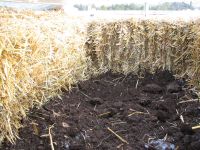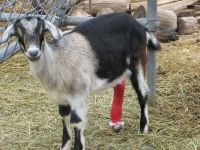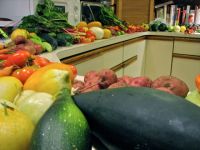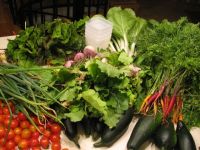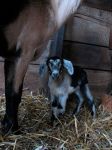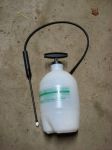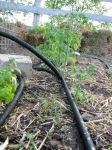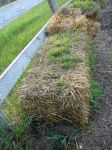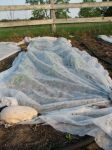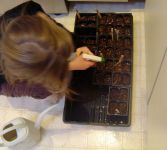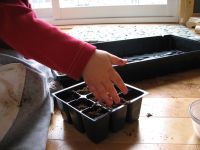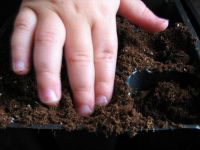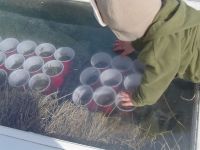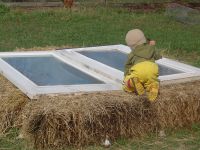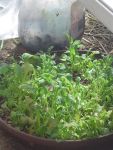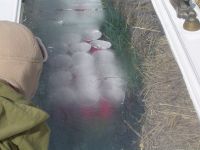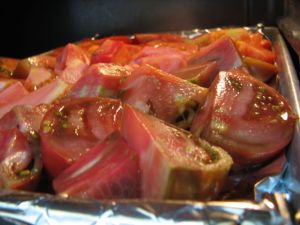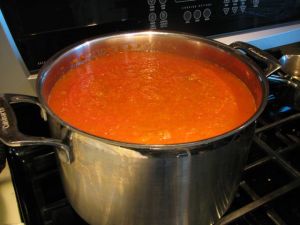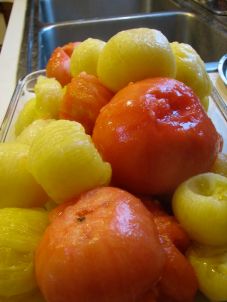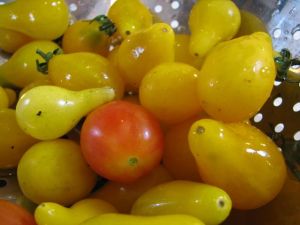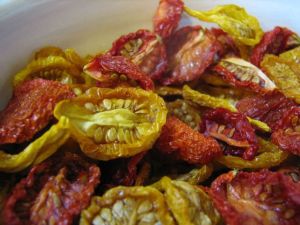I, being an obsessively resourceful person, happen to think that foraging for things to eat that grow from the earth without any human intervention is one of the most satisfying things I could possibly do. It’s a fantastic way to get out into nature and really understand the environment around you, (because if you’re going to wild-forage you have to understand your environment or you could end up dead). It’s something our ancestors did not all that long ago. But somehow, in the ever-increasing gap between people and the origins of food many of us have lost our ability to hunt and/or gather. Now I’m not going to be talking about hunting in this post, (or probably ever, for that matter). It’s not something I have any ethical issue with, it’s just not something that I or anyone in my family does. Well, there was that one time my husband took a deer but it was with a very expensive bullet -his truck. Being the obsessively resourceful people we are, we did process it and put it in our freezer. However, I don’t recommend hunting with your vehicle as a great way to put meat on the table.
Anyway, foraging for me gives me this great sense of awe for the life around me that exists without anything I’ve done to make it that way. To walk out of a field or the woods with something my family can eat really makes me think about how so much of what we have in all of life we get for free out of no merit any of us have earned. I think when we are so separated from the origins of food one thing we really loose is the appreciation for what we’ve been given for nothing we’ve done. When you walk into a grocery store with money in your pocket that you’ve earned from working and buy your groceries it’s easy to feel a sense of entitlement. I earned the money, I bought the food = I’m entitled to this food. But I don’t think that’s really all that indicative of reality. If anything it’s a simplistic and cheapened reality. Because the truth is, you didn’t earn the money to make the sun shine or the rain fall. You didn’t plan a training session to teach the micro-organisms to break down the dead and turn it into new life. The bees aren’t such fantastic pollinators because you’ve done such a great job managing them. Yet, without these things the food wouldn’t be in the grocery store for you to buy to begin with. So much of life is given to us and for me, foraging is a great and concrete reminder of this.
Here is a sampling of what I found this summer. But first, a disclaimer: Although there are many safe things to forage don’t go out and eat things you’re unsure of. Make sure you know what you’re doing or are with someone who knows.
“Wild” Apples
These may not be exactly “wild”. This year I got apples from two different orchards that had been unkempt for quite a few years. However, in the past I’ve also gathered apples from trees that happen to grow on the side of the road or randomly in the woods. Often times these apples are misshapen, a little wormy and otherwise just plain ugly. However, with a little work they are great for applesauce, apple butter or apple jelly. I’m always constantly amazed at people who say things like, “You can’t eat those apples, those haven’t been taken care of for years!” Apples are apples, I say and I can eat them wild or not. Besides, if they’ve grown wild for several years then I know that no pesticides have been used on them. They are free “organic” apples. It’s completely worth taking the time to peel them, slice them, clean them up and make them into applesauce. Applesauce is one of the easiest things to make and can at home. This year we made over 2 gallons of applesauce from wild apples.
“Wild” Grapes
These can be actual wild grapes or again, grapes from vines that haven’t been used in years. The grapes in my pictures are Concord grapes that are from unkempt vines. Wild grapes are smaller and more tart -but often great for juice or jelly. Unkempt grapes are easy to spot because of their size. However, wild grapes do have a somewhat dangerous lookalike, the Moonseed plant. This is a vining plant like the grape but there are a couple of important differences. Grapes have a couple of small seeds inside while the Moonseed plant has one big crescent-shaped seed, (thus, “Moon”seed). Birds can eat them with no harm but humans cannot without severe abdominal pain.
Wild Strawberries
This is a really safe little plant. There isn’t anything else that I know of that looks like a strawberry but a strawberry. They love to grow in sandy places where everything else seems to struggle for life. My kids are out picking them everyday in mid-summer. If you can gather enough they make a great jam. They are tiny but pack a powerful little strawberry punch compared to what we find in the stores.
Autumn Olives

A few Autumn Olives
Red berries in the wild can be a dangerous thing. However, as a general rule, it’s a good idea to stay away from red berries on weeds, (like Nightshade) while berries on woody shrubs and bushes are more likely to be edible, (but that doesn’t mean they’ll taste good). Also, just because you see birds eating a berry doesn’t mean you can. Watching bats feed will actually give you a better idea of what we can eat. However, again, it’s not foolproof. Luckily the Autumn Olive is an easy plant to identify if you know what you are doing. It’s a woody shrub with silvery elongated leaves that resemble those of the olive tree. It can grow up to 20 feet. In America it’s an invasive, (but delicious!) species and can take over a field. It does very well in poor soils because of the way it fixes nitrogen in it’s root system. It comes from Asia and was introduced around 1830 as a potential commercial crop. Why it isn’t a commercial, I’m not sure, because it’s a fantastic and prolific little berry. It has a delightfully sweet, tart and almost spicy flavor reminiscent of cloves or cinnamon. I found a field just full of these bushes this year -every shrub with branches heavy with berries. The juice is a wonderful bright pink color and so is the jelly made from it. It not only tastes good, it’s absolutely beautiful to look at. It also happens to be a great source of natural lycopene.
Morel Mushrooms
Ah, mushroom hunting. It can be really fun or really frustrating. For me it tends to be frustrating but this year I actually found a few. Morels are fairly easy to recognize. Although, again, mushroom hunting is not something you should attempt to do unless you are quite confident about your identification skills. The morel grows in the forest, (most of the time, it sometimes makes up it’s own rules). It pops out of the ground the best when the days are wet and the nights are warm. They are frustratingly difficult to find due to the fact that they blend in with their environment extremely well. We usually just eat the ones we find but you can also dry them and use them later or sell them for $50/lb on the side of the road to passing tourists who will pay that much.
Purslane
Ah! This one is fantastic! It grows almost everywhere in the world as a weedy ground cover. It’s also eaten in most places in the world other than the US. It has a delightful lemony flavor later in the season, (in the beginning of the season it just tastes like…well, a weed). It also is one of the highest plant sources of Omega 3 fatty acids. The type of fatty acid it contains in high levels is similar to the kind found in fish. You can juice it, throw it into salads, put it on a sandwich, and more. I actually like it in Tabouleh. In fact, in my favorite cooking book, The Joy of Cooking, it’s actually listed as an ingredient!
Mint
This is something else I wild-forage and use in many ways. You can often find it growing near a stream or a body of water. It’s easy to tell what it is because it’s…minty. There are many kids all with slightly different flavors. I gather mint all through the summer and use it in tea, tabbouleh and the occasional mojito. You can even store your mint cuttings in water and they will grow roots. You can plant these rooted stems if you’d like them to take over your yard. Otherwise, the fact that they grow roots allows for you to keep a little mint alive a long time in a glass of water in a windowsill.
St Johns Wort
This one is an herb. It’s often everywhere you look and you’ve probably stepped right on it at some point in the year, (depressing, isn’t it?) It’s a weedy yellow flowering plant. Gather the plants when they are in full flower and dry them. At that point you can use the plants for tea. St Johns Wort tea is often known as “liquid sunshine” perhaps because of it’s bright yellow color or because of it’s stated ability to improve your mood. I saved some for the long, cold, dark months of winter this year. I’ll let you know how it works.
Blackberries/Black Raspberries/Red Raspberries
This is another wild plant that is easy to identify because they look like nothing else. All are found in thorny patches of briars. Blackberries tend to be low to the ground with huge, leg-gashing thorns while Black Raspberries and Red Raspberries tend to grow higher with more delicate thorns. Blackberries come off the stem core intact while Raspberries, (black and red) leave the core on the plant and come off the stem “hollow”. They are usually easy to find and easy to pick. Don’t pick them all, however, because the wildlife often relies on them for food. Also, if you happen to be picking where there are bears keep an eye out, they are fellow omnivores who like them too!
There are many, many more plants I could list and perhaps I will in the future. But for now, some pictures of this summers wild harvest.
-

-
Bright Pink Autumn Olive Juice!
-

-
Mint in the top left
-

-
Pretty Autumn Olive Jelly
-
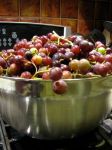
-
“Wild” Grapes
-

-
A few Autumn Olives
-
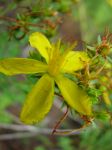
-
St Johns Wort Flower
-
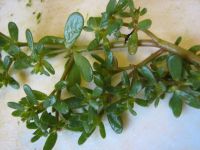
-
Purslane!
-

-
Autumn Olives
-
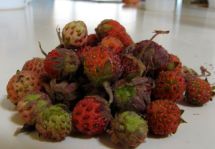
-
Wild Strawberries
-

-
Morel Mushrooms
-

-
Autumn Olive Juice
-

-
Wild Blackberries

